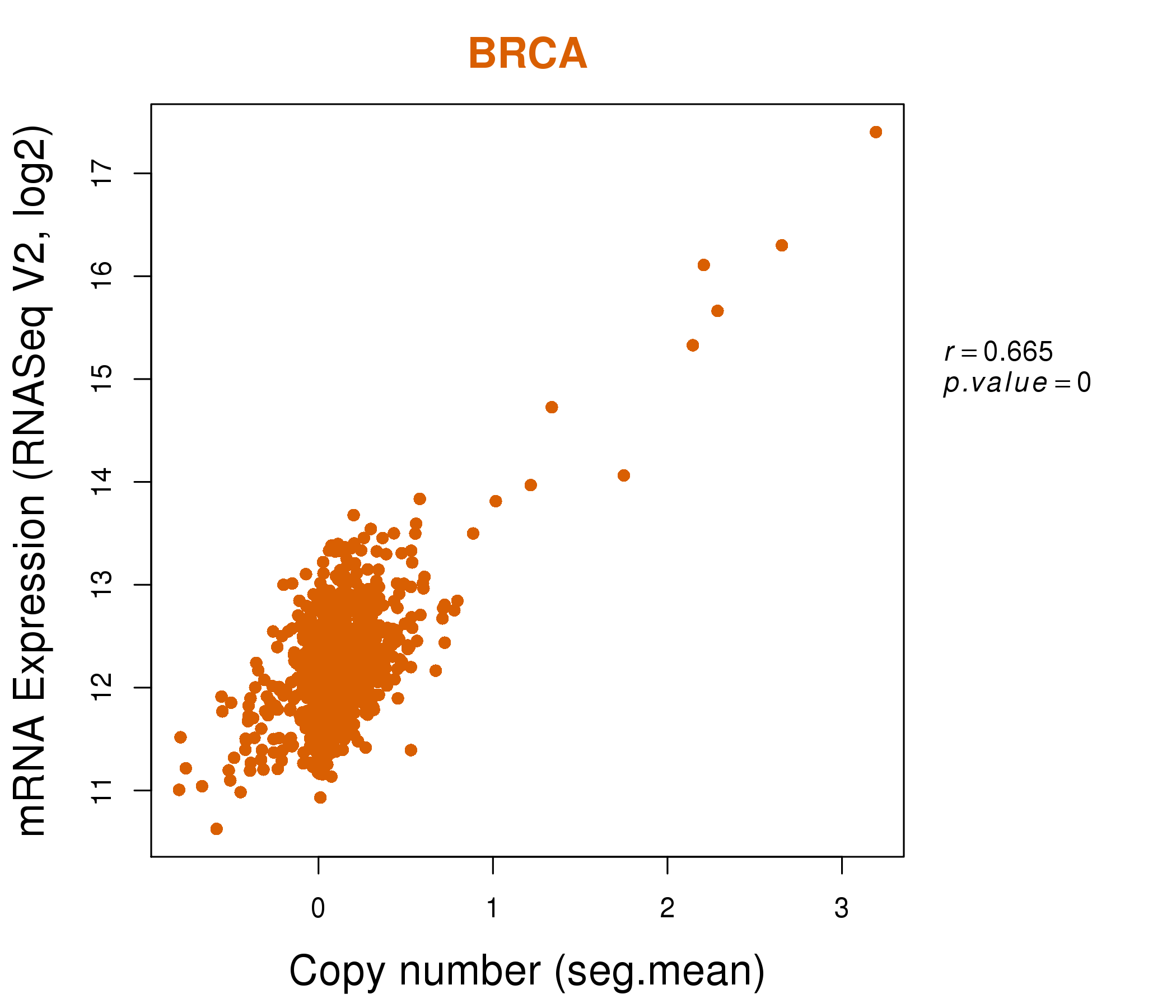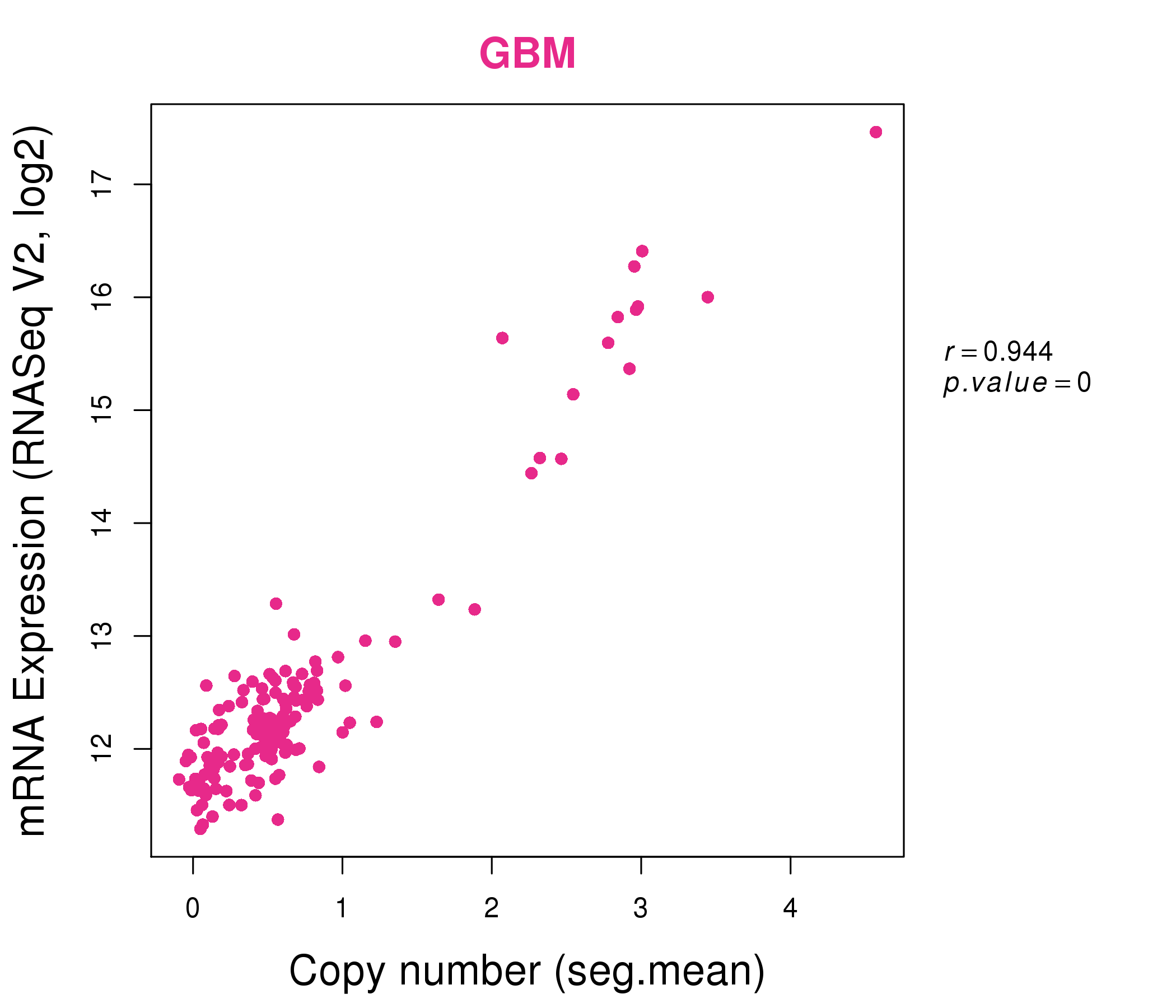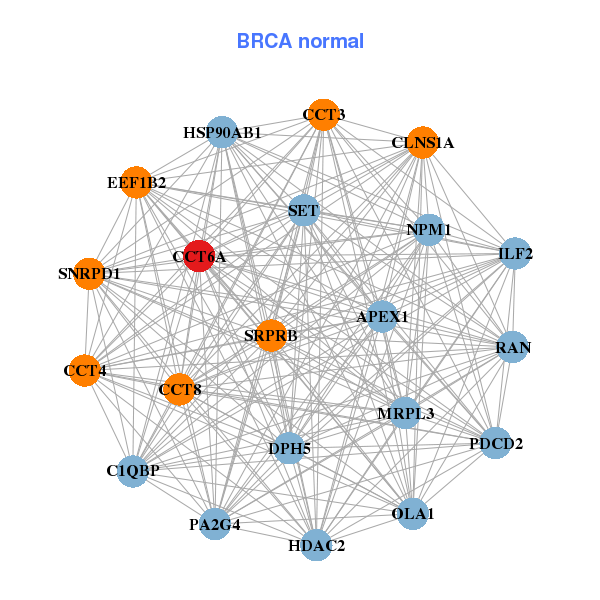|
||||||||||||||||||||||||||||||||||||||||||||||||||||||||||||||||||||||||||||||||||||||||||||||||||||||||||||||||||||||||||||||||||||||||||||||||||||||||||||||||||||||||||||||||||||||||||||||||||||||||||||||||||||||||||||||||||||||||||||||||||||||||||||||||||||||||||||||||||||||||||||||||||||||||||||||||||||||||||
| |
| Phenotypic Information (metabolism pathway, cancer, disease, phenome) |
| |
| |
| Gene-Gene Network Information: Co-Expression Network, Interacting Genes & KEGG |
| |
|
| Gene Summary for CCT6A |
| Basic gene info. | Gene symbol | CCT6A |
| Gene name | chaperonin containing TCP1, subunit 6A (zeta 1) | |
| Synonyms | CCT-zeta|CCT-zeta-1|CCT6|Cctz|HTR3|MoDP-2|TCP-1-zeta|TCP20|TCPZ|TTCP20 | |
| Cytomap | UCSC genome browser: 7p11.2 | |
| Genomic location | chr7 :56119377-56131682 | |
| Type of gene | protein-coding | |
| RefGenes | NM_001009186.1, NM_001762.3, | |
| Ensembl id | ENSG00000146731 | |
| Description | T-complex protein 1 subunit zetaT-complex protein 1, zeta subunitacute morphine dependence related protein 2acute morphine dependence-related protein 2amino acid transport defect-complementingchaperonin containing T-complex subunit 6histidine transp | |
| Modification date | 20141207 | |
| dbXrefs | MIM : 104613 | |
| HGNC : HGNC | ||
| Ensembl : ENSG00000146731 | ||
| HPRD : 00089 | ||
| Vega : OTTHUMG00000022842 | ||
| Protein | UniProt: go to UniProt's Cross Reference DB Table | |
| Expression | CleanEX: HS_CCT6A | |
| BioGPS: 908 | ||
| Gene Expression Atlas: ENSG00000146731 | ||
| The Human Protein Atlas: ENSG00000146731 | ||
| Pathway | NCI Pathway Interaction Database: CCT6A | |
| KEGG: CCT6A | ||
| REACTOME: CCT6A | ||
| ConsensusPathDB | ||
| Pathway Commons: CCT6A | ||
| Metabolism | MetaCyc: CCT6A | |
| HUMANCyc: CCT6A | ||
| Regulation | Ensembl's Regulation: ENSG00000146731 | |
| miRBase: chr7 :56,119,377-56,131,682 | ||
| TargetScan: NM_001009186 | ||
| cisRED: ENSG00000146731 | ||
| Context | iHOP: CCT6A | |
| cancer metabolism search in PubMed: CCT6A | ||
| UCL Cancer Institute: CCT6A | ||
| Assigned class in ccmGDB | C | |
| Top |
| Phenotypic Information for CCT6A(metabolism pathway, cancer, disease, phenome) |
| Cancer | CGAP: CCT6A |
| Familial Cancer Database: CCT6A | |
| * This gene is included in those cancer gene databases. |
|
|
|
|
|
| . | ||||||||||||||||||||||||||||||||||||||||||||||||||||||||||||||||||||||||||||||||||||||||||||||||||||||||||||||||||||||||||||||||||||||||||||||||||||||||||||||||||||||||||||||||||||||||||||||||||||||||||||||||||||||||||||||||||||||||||||||||||||||||||||||||||||||||||||||||||||||||||||||||||||||||||||||||||||
Oncogene 1 | Significant driver gene in | |||||||||||||||||||||||||||||||||||||||||||||||||||||||||||||||||||||||||||||||||||||||||||||||||||||||||||||||||||||||||||||||||||||||||||||||||||||||||||||||||||||||||||||||||||||||||||||||||||||||||||||||||||||||||||||||||||||||||||||||||||||||||||||||||||||||||||||||||||||||||||||||||||||||||||||||||||||||||
| cf) number; DB name 1 Oncogene; http://nar.oxfordjournals.org/content/35/suppl_1/D721.long, 2 Tumor Suppressor gene; https://bioinfo.uth.edu/TSGene/, 3 Cancer Gene Census; http://www.nature.com/nrc/journal/v4/n3/abs/nrc1299.html, 4 CancerGenes; http://nar.oxfordjournals.org/content/35/suppl_1/D721.long, 5 Network of Cancer Gene; http://ncg.kcl.ac.uk/index.php, 1Therapeutic Vulnerabilities in Cancer; http://cbio.mskcc.org/cancergenomics/statius/ |
| REACTOME_METABOLISM_OF_PROTEINS | |
| OMIM | |
| Orphanet | |
| Disease | KEGG Disease: CCT6A |
| MedGen: CCT6A (Human Medical Genetics with Condition) | |
| ClinVar: CCT6A | |
| Phenotype | MGI: CCT6A (International Mouse Phenotyping Consortium) |
| PhenomicDB: CCT6A | |
| Mutations for CCT6A |
| * Under tables are showing count per each tissue to give us broad intuition about tissue specific mutation patterns.You can go to the detailed page for each mutation database's web site. |
| There's no structural variation information in COSMIC data for this gene. |
| * From mRNA Sanger sequences, Chitars2.0 arranged chimeric transcripts. This table shows CCT6A related fusion information. |
| ID | Head Gene | Tail Gene | Accession | Gene_a | qStart_a | qEnd_a | Chromosome_a | tStart_a | tEnd_a | Gene_a | qStart_a | qEnd_a | Chromosome_a | tStart_a | tEnd_a |
| Top |
| Mutation type/ Tissue ID | brca | cns | cerv | endome | haematopo | kidn | Lintest | liver | lung | ns | ovary | pancre | prost | skin | stoma | thyro | urina | |||
| Total # sample | 1 | 2 | ||||||||||||||||||
| GAIN (# sample) | 1 | 2 | ||||||||||||||||||
| LOSS (# sample) |
| cf) Tissue ID; Tissue type (1; Breast, 2; Central_nervous_system, 3; Cervix, 4; Endometrium, 5; Haematopoietic_and_lymphoid_tissue, 6; Kidney, 7; Large_intestine, 8; Liver, 9; Lung, 10; NS, 11; Ovary, 12; Pancreas, 13; Prostate, 14; Skin, 15; Stomach, 16; Thyroid, 17; Urinary_tract) |
| Top |
|
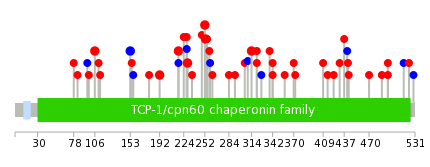 |
| Top |
| Stat. for Non-Synonymous SNVs (# total SNVs=41) | (# total SNVs=8) |
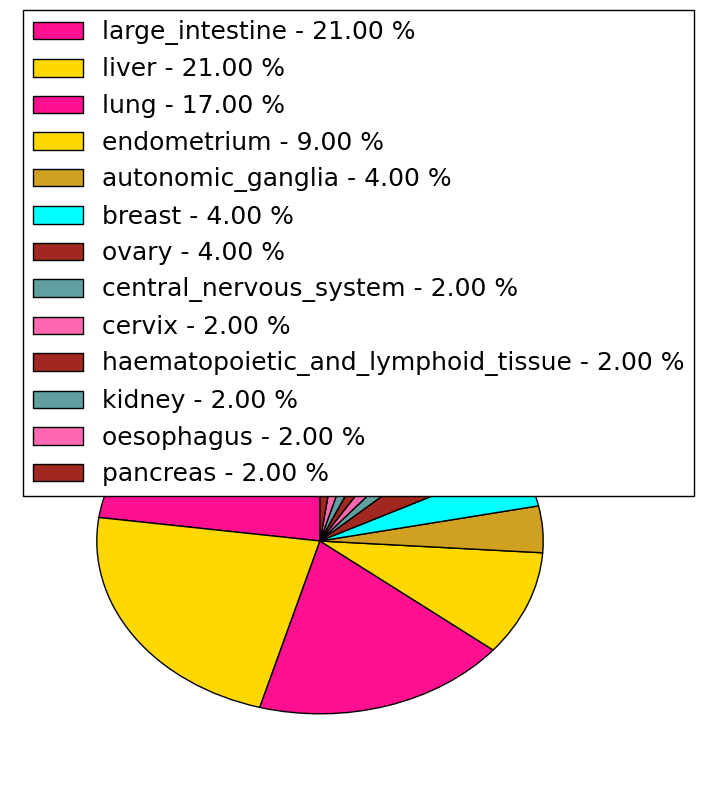 | 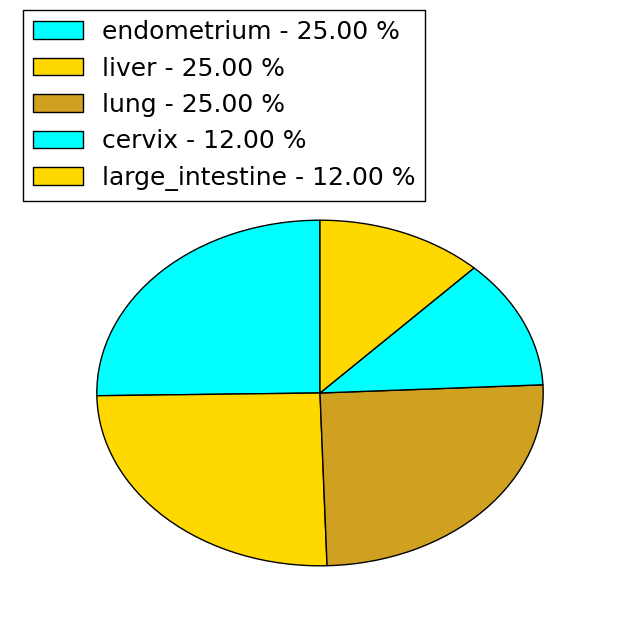 |
(# total SNVs=5) | (# total SNVs=1) |
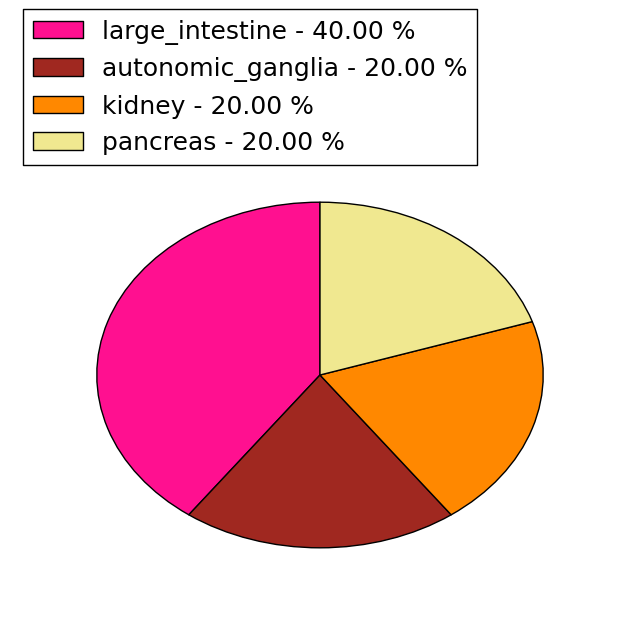 | 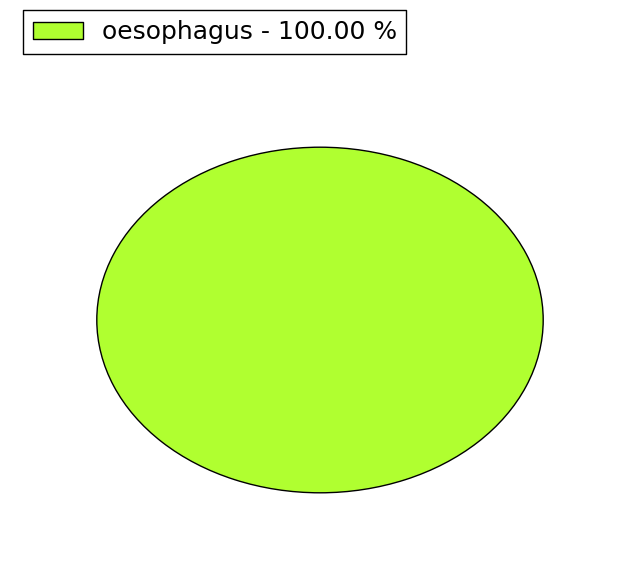 |
| Top |
| * When you move the cursor on each content, you can see more deailed mutation information on the Tooltip. Those are primary_site,primary_histology,mutation(aa),pubmedID. |
| GRCh37 position | Mutation(aa) | Unique sampleID count |
| chr7:56126143-56126143 | p.I274fs*1 | 3 |
| chr7:56122177-56122177 | p.A106V | 2 |
| chr7:56127292-56127292 | p.D342H | 2 |
| chr7:56125757-56125757 | p.Y229C | 2 |
| chr7:56123437-56123437 | p.R153R | 2 |
| chr7:56126071-56126071 | p.Y250fs*11 | 2 |
| chr7:56126085-56126085 | p.S252R | 2 |
| chr7:56124067-56124067 | p.E192Q | 2 |
| chr7:56126087-56126087 | p.A253E | 2 |
| chr7:56126368-56126368 | p.R314H | 2 |
| Top |
|
 |
| Point Mutation/ Tissue ID | 1 | 2 | 3 | 4 | 5 | 6 | 7 | 8 | 9 | 10 | 11 | 12 | 13 | 14 | 15 | 16 | 17 | 18 | 19 | 20 |
| # sample | 1 | 1 | 1 | 5 | 1 | 3 | 5 | 3 | 2 | 6 | 6 | |||||||||
| # mutation | 1 | 1 | 2 | 5 | 1 | 3 | 5 | 3 | 2 | 7 | 6 | |||||||||
| nonsynonymous SNV | 1 | 1 | 1 | 4 | 1 | 2 | 5 | 1 | 1 | 5 | 4 | |||||||||
| synonymous SNV | 1 | 1 | 1 | 2 | 1 | 2 | 2 |
| cf) Tissue ID; Tissue type (1; BLCA[Bladder Urothelial Carcinoma], 2; BRCA[Breast invasive carcinoma], 3; CESC[Cervical squamous cell carcinoma and endocervical adenocarcinoma], 4; COAD[Colon adenocarcinoma], 5; GBM[Glioblastoma multiforme], 6; Glioma Low Grade, 7; HNSC[Head and Neck squamous cell carcinoma], 8; KICH[Kidney Chromophobe], 9; KIRC[Kidney renal clear cell carcinoma], 10; KIRP[Kidney renal papillary cell carcinoma], 11; LAML[Acute Myeloid Leukemia], 12; LUAD[Lung adenocarcinoma], 13; LUSC[Lung squamous cell carcinoma], 14; OV[Ovarian serous cystadenocarcinoma ], 15; PAAD[Pancreatic adenocarcinoma], 16; PRAD[Prostate adenocarcinoma], 17; SKCM[Skin Cutaneous Melanoma], 18:STAD[Stomach adenocarcinoma], 19:THCA[Thyroid carcinoma], 20:UCEC[Uterine Corpus Endometrial Carcinoma]) |
| Top |
| * We represented just top 10 SNVs. When you move the cursor on each content, you can see more deailed mutation information on the Tooltip. Those are primary_site, primary_histology, mutation(aa), pubmedID. |
| Genomic Position | Mutation(aa) | Unique sampleID count |
| chr7:56123378 | p.R112R,CCT6A | 1 |
| chr7:56130769 | p.M276V,CCT6A | 1 |
| chr7:56126106 | p.D142H,CCT6A | 1 |
| chr7:56127968 | p.A282A,CCT6A | 1 |
| chr7:56123444 | p.R172Q,CCT6A | 1 |
| chr7:56126114 | p.D293N,CCT6A | 1 |
| chr7:56128005 | p.R172R,CCT6A | 1 |
| chr7:56123451 | p.H301Y,CCT6A | 1 |
| chr7:56126203 | p.R179K,CCT6A | 1 |
| chr7:56128511 | p.E313Q,CCT6A | 1 |
| * Copy number data were extracted from TCGA using R package TCGA-Assembler. The URLs of all public data files on TCGA DCC data server were gathered on Jan-05-2015. Function ProcessCNAData in TCGA-Assembler package was used to obtain gene-level copy number value which is calculated as the average copy number of the genomic region of a gene. |
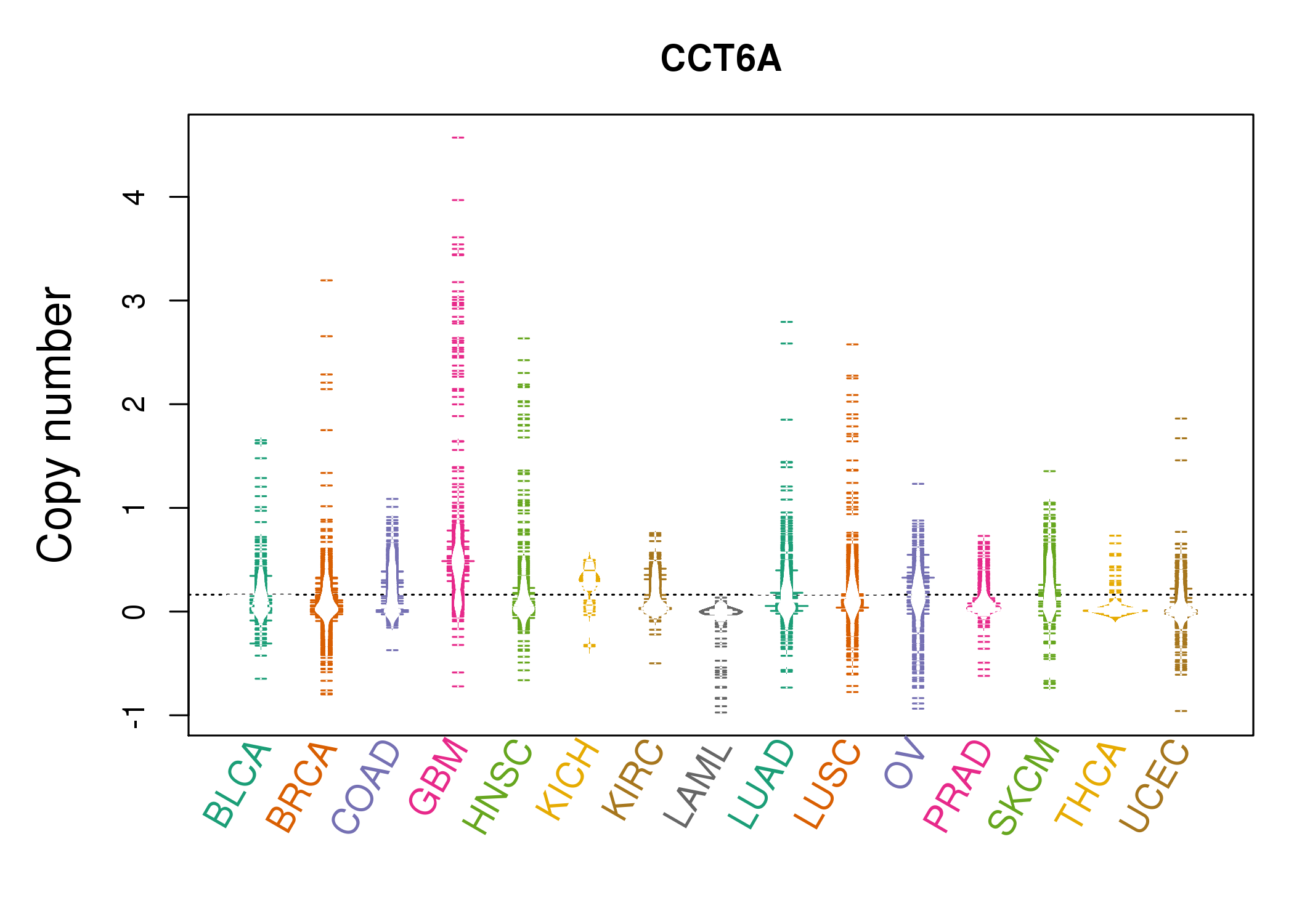 |
| cf) Tissue ID[Tissue type]: BLCA[Bladder Urothelial Carcinoma], BRCA[Breast invasive carcinoma], CESC[Cervical squamous cell carcinoma and endocervical adenocarcinoma], COAD[Colon adenocarcinoma], GBM[Glioblastoma multiforme], Glioma Low Grade, HNSC[Head and Neck squamous cell carcinoma], KICH[Kidney Chromophobe], KIRC[Kidney renal clear cell carcinoma], KIRP[Kidney renal papillary cell carcinoma], LAML[Acute Myeloid Leukemia], LUAD[Lung adenocarcinoma], LUSC[Lung squamous cell carcinoma], OV[Ovarian serous cystadenocarcinoma ], PAAD[Pancreatic adenocarcinoma], PRAD[Prostate adenocarcinoma], SKCM[Skin Cutaneous Melanoma], STAD[Stomach adenocarcinoma], THCA[Thyroid carcinoma], UCEC[Uterine Corpus Endometrial Carcinoma] |
| Top |
| Gene Expression for CCT6A |
| * CCLE gene expression data were extracted from CCLE_Expression_Entrez_2012-10-18.res: Gene-centric RMA-normalized mRNA expression data. |
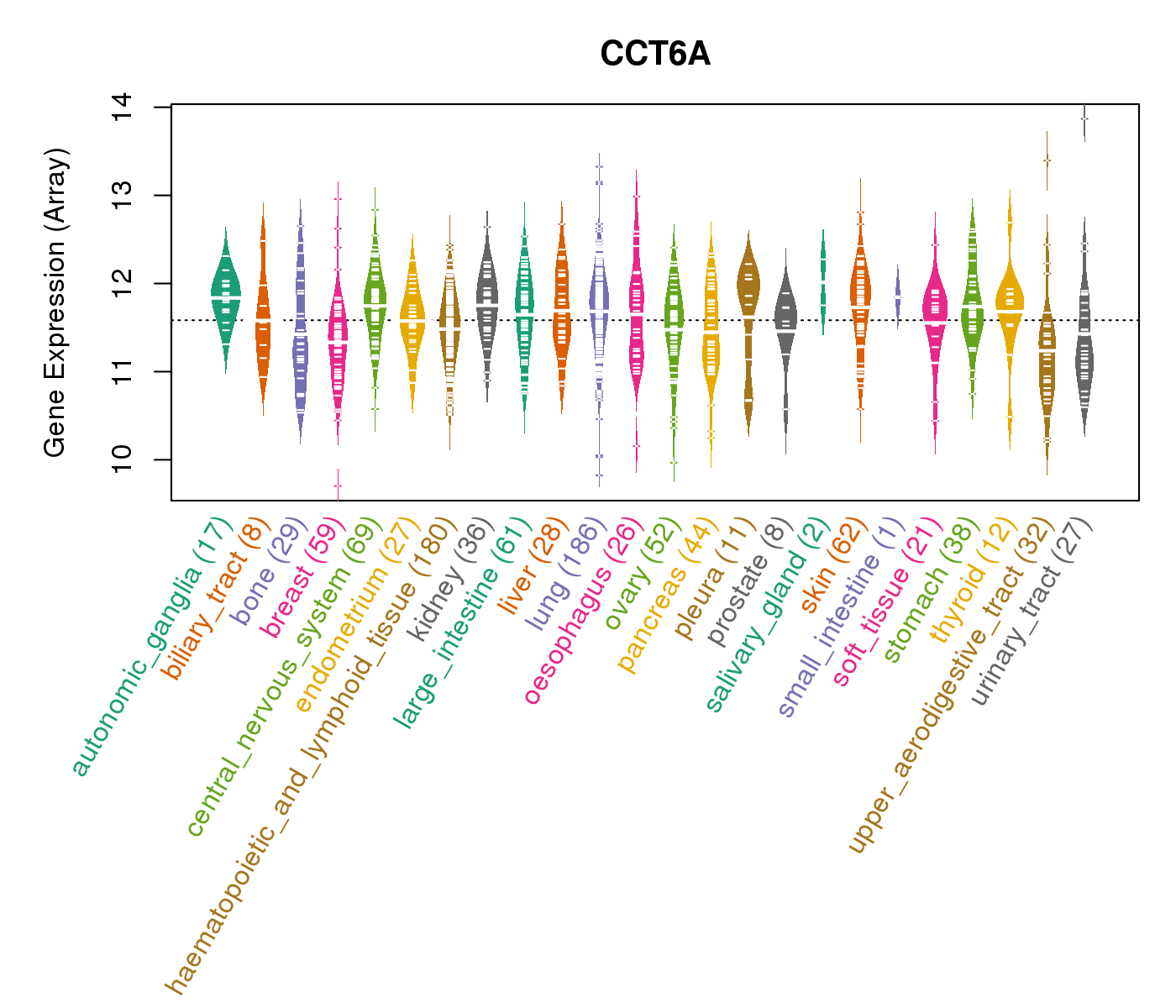 |
| * Normalized gene expression data of RNASeqV2 was extracted from TCGA using R package TCGA-Assembler. The URLs of all public data files on TCGA DCC data server were gathered at Jan-05-2015. Only eight cancer types have enough normal control samples for differential expression analysis. (t test, adjusted p<0.05 (using Benjamini-Hochberg FDR)) |
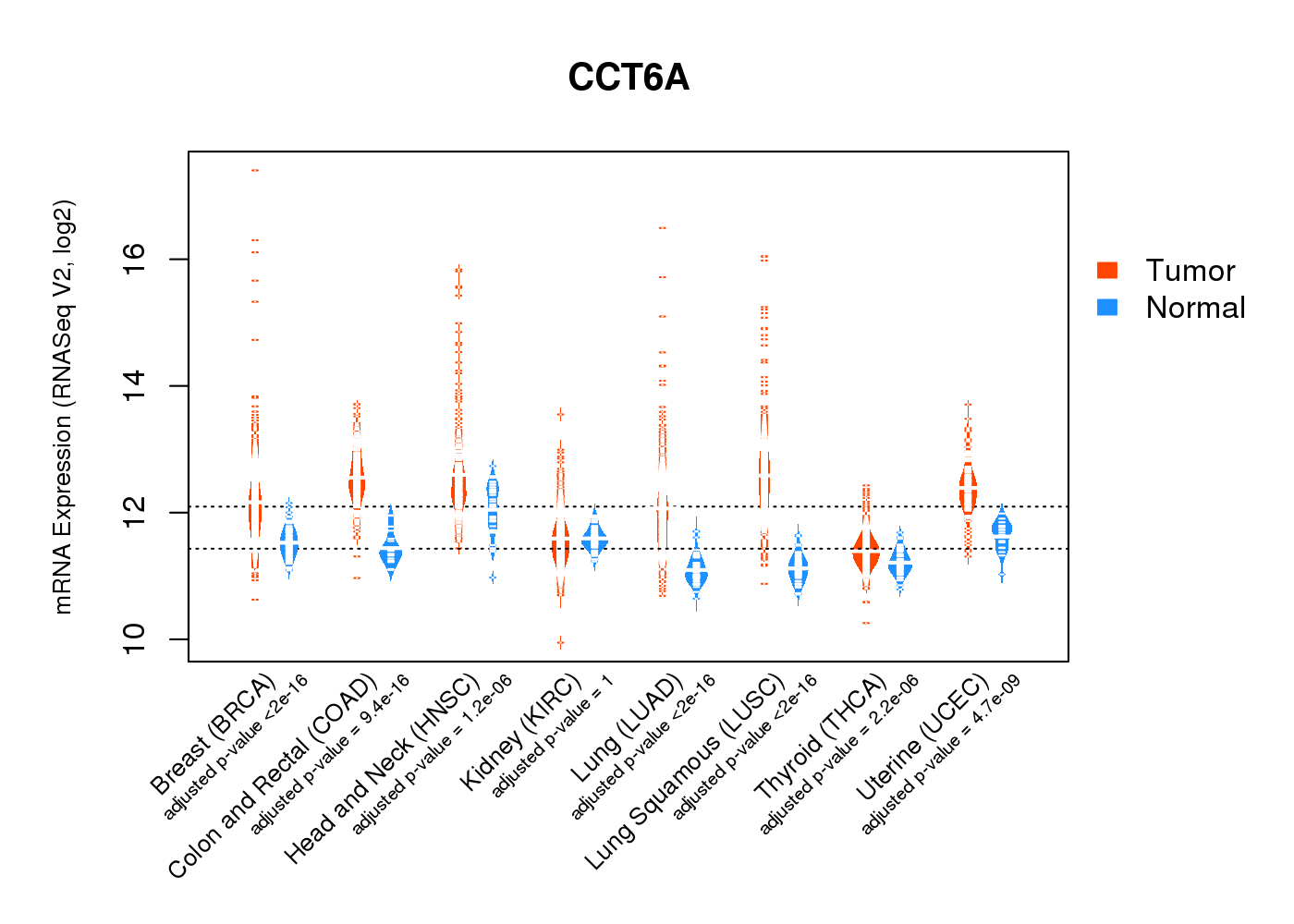 |
| Top |
| * This plots show the correlation between CNV and gene expression. |
: Open all plots for all cancer types
 |
|
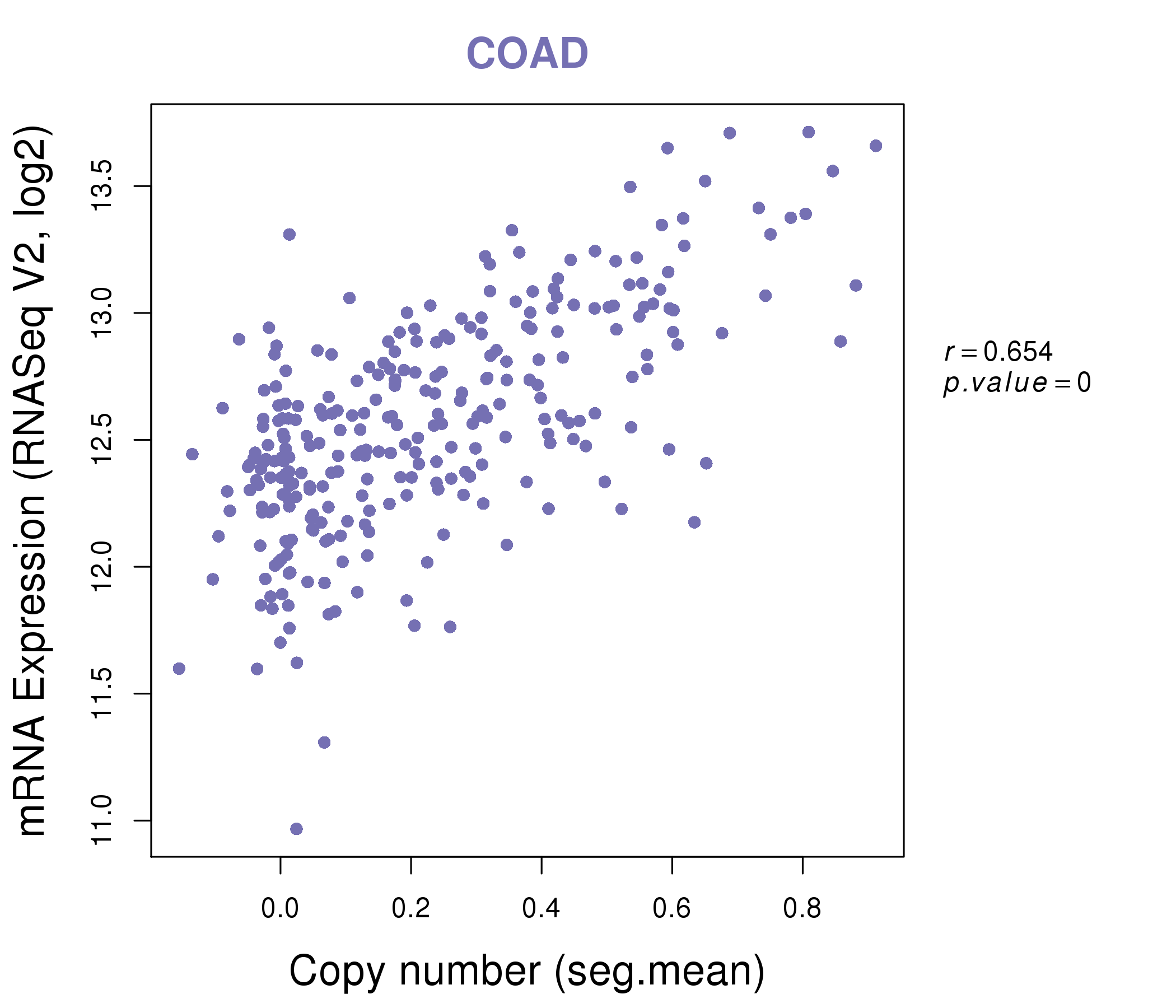 |
|
| Top |
| Gene-Gene Network Information |
| * Co-Expression network figures were drawn using R package igraph. Only the top 20 genes with the highest correlations were shown. Red circle: input gene, orange circle: cell metabolism gene, sky circle: other gene |
: Open all plots for all cancer types
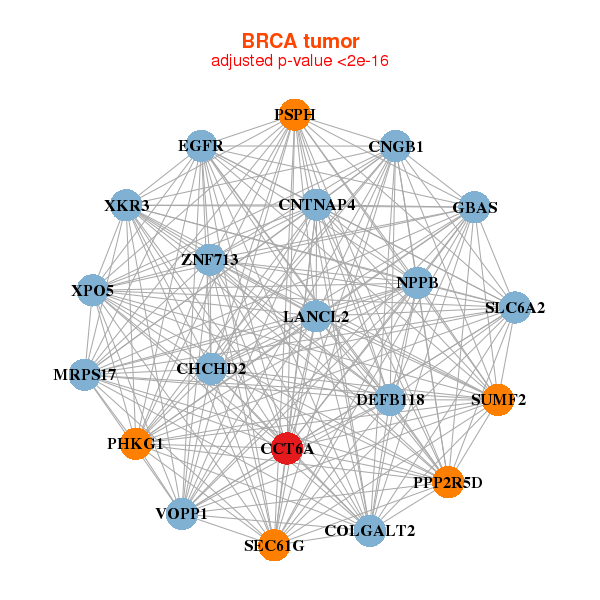 |
|
| CCT6A,CHCHD2,CNGB1,CNTNAP4,DEFB118,EGFR,GBAS, COLGALT2,LANCL2,MRPS17,NPPB,PHKG1,PPP2R5D,PSPH, SEC61G,SLC6A2,SUMF2,VOPP1,XKR3,XPO5,ZNF713 | APEX1,C1QBP,CCT3,CCT4,CCT6A,CCT8,CLNS1A, DPH5,EEF1B2,HDAC2,HSP90AB1,ILF2,MRPL3,NPM1, OLA1,PA2G4,PDCD2,RAN,SET,SNRPD1,SRPRB |
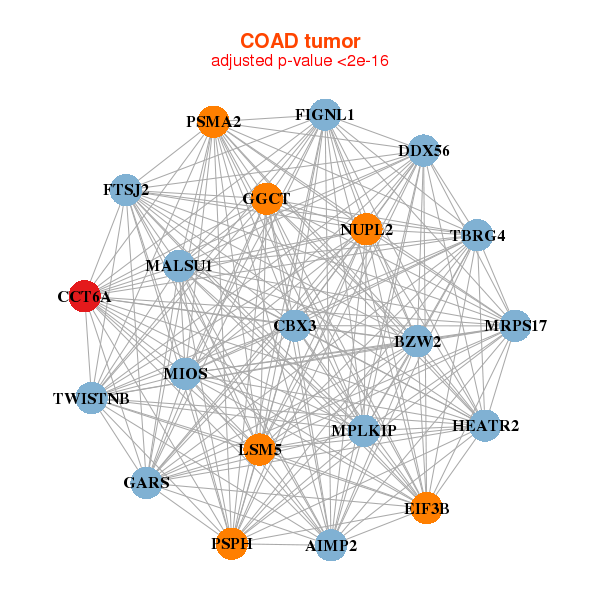 |
|
| AIMP2,BZW2,MPLKIP,MALSU1,CBX3,CCT6A,DDX56, EIF3B,FIGNL1,FTSJ2,GARS,GGCT,HEATR2,LSM5, MIOS,MRPS17,NUPL2,PSMA2,PSPH,TBRG4,TWISTNB | ABCE1,BCCIP,CCT2,CCT5,CCT6A,DKC1,EIF3J, EIF4A1,FARSB,GTPBP4,HSPD1,LYAR,NOL10,PA2G4, PAICS,RANBP1,STIP1,TIPIN,UMPS,VRK1,WDR77 |
| * Co-Expression network figures were drawn using R package igraph. Only the top 20 genes with the highest correlations were shown. Red circle: input gene, orange circle: cell metabolism gene, sky circle: other gene |
: Open all plots for all cancer types
| Top |
: Open all interacting genes' information including KEGG pathway for all interacting genes from DAVID
| Top |
| Pharmacological Information for CCT6A |
| There's no related Drug. |
| Top |
| Cross referenced IDs for CCT6A |
| * We obtained these cross-references from Uniprot database. It covers 150 different DBs, 18 categories. http://www.uniprot.org/help/cross_references_section |
: Open all cross reference information
|
Copyright © 2016-Present - The Univsersity of Texas Health Science Center at Houston @ |






